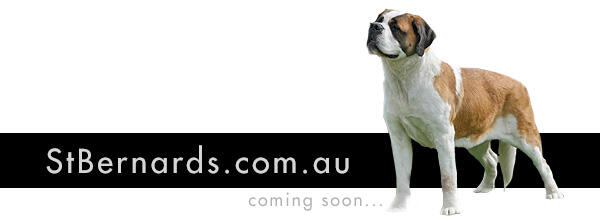
THE SAINT BERNARD
History
The Saint Bernard originates from Switzerland. The dog was the originally named the "Alpine Mastiff" amongst others.
In the late 1700's the Monks at the Great Hospice of St Bernard, were using the dogs for haulage, companionship and watchdog duties. They noticed that the dogs had a superior sense of smell and could find a person in distress in the appalling weather conditions. The Monks encouraged this type of work and began to breed Saint Bernard's specifically for this purpose. The most famous Saint Bernard "Barry" rescued some 40 people in the Swiss mountains and today his body can be viewed at the Berne Museum.
The breed was standardised in the early 1880's with a stud register being commenced in Switzerland, resulting in the breed becoming known as the "Saint Bernard". At the same time, the breed was becoming more popular in Europe, the United States and England.The Saint Bernard Club of America formed in 1888, and in other countries as the breed became more known.
Here in Australia, the oldest Saint Bernard Club is the Saint Bernard Club of Victoria,
which formed in 1975, and is affiliated with the Victorian Canine Association (VCA).
Other affiliated clubs in Australia, are the Saint Bernard Club of NSW, QLD and WA.
There are also clubs in Tasmania and South Australia, however they are not affiliated
to their State Canine Association.
The Saint Bernard has been portrayed in many films and on television. Most notably, the Beethoven series of films, have lifted the profile of the breed significantly around the world.
What to look for in a Saint Bernard
Temperament
The Saint Bernard is a highly intelligent dog.Ideally, the Saint Bernard will be at home with both humans and other animals. As the dog is the biggest dog in the world (height/weight), its temperament is crucial, hence it must be able to get on with everyone and anything in all types of situations.
Lifespan
Saint Bernard's live for an average of 8 years. They have lived for up to 14 years. The lifespan of the dog, will depend on its parentage and how well the Saint Bernard is kept.
Exercise
This breed does require some exercise. Most importantly the Saint Bernard is highly intelligent and is an excellent dog at obedience and agility type work. It is recommended that the Saint Bernard be socialised from early on, ideally from 10 weeks of age onwards, with other breeds, other animals and people.
Most importantly, do not encourage your Saint Bernard to jump around at an early age. The breed develops rapidly, a 6 month old dog can often weigh more than 50Kg. The dogs bones are still soft, up to 12 months of age, when the boning has fully developed in strength.
When fully grown, an adult Saint Bernard, should be walked a minimum of 3 times per week for at least 30 minutes a time.
Feeding
This breed grows rapidly. Ideally, the Saint Bernard has the best opportunity to develop if fed a Super Premium Dry Food, eg: Eagle, Eukanuba, Hills Science Diet etc. A fully grown Saint Bernard would eat approximately 25Kg of Super Premium Dry Food per month, costing $90.00 plus, around $3.00 per day.
As a puppy, it is best if one can feed their Saint Bernard a Super Premium Dry Food for the first 12 months of the Saint Bernard's development. Super Premium Dry Food's unlike supermarket brands, are scientifically developed to optimise the Saint Bernard's development.
Grooming
There are two types of Saint Bernard the "Smoothcoat" and the "Roughcoat". The Smoothcoat is the original Saint Bernard, and has a short coat similar to the Labrador. Its grooming requirement is medium, a good brush and comb used for 15 minutes, twice weekly will keep your Smoothcoat looking good.
The Roughcoat requires more time, as its coat is somewhat longer. On average a good brush and combing will take approximately 25 minutes twice weekly.
The dogs should be washed at least monthly, using a good animal shampoo (do not use human grade shampoo's, as a dogs skin can be burnt using our shampoo's).
Accommodation
It should be decided before you bring your Saint Bernard home, as to whether the Saint Bernard, will be an indoor dog or outdoor dog. If you elect to have your dog outdoors, the Saint Bernard, will require a draft free shelter from both rain and sunshine. Please make sure your yard is secure and the Saint Bernard cannot wander off your property. Also do not ever chain your dog up, it is cruel to keep your dog on a chain and the dog can injure themselves whilst chained.
Indoors, the Saint Bernard should have its own private sleeping area. Many Dog Product stores, have suitable beds that will accommodate your Saint Bernard either indoor or outside.
Car Travel
If you elect to travel around with your Saint Bernard in the car, it is recommended that you have a cargo barrier fitted, so the dog is safe in the back of the car.
Vet Care
The Saint Bernard, being a giant breed can and do on occasion present their owners with a giant vet account. In the main the breed is very hardy and enduring. The dog should have at least once a year, a vet check that incorporates its annual vaccination.
Size: The minimum height for males is 27.5 inches at the shoulder and bitches 25.5 inches at the shoulder.
Weight: Dogs can reach up to 90Kg plus with bitches achieving 70Kg plus.